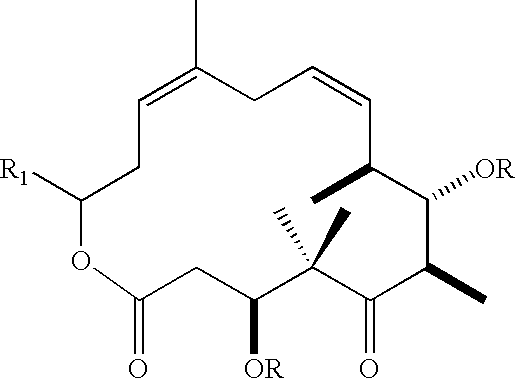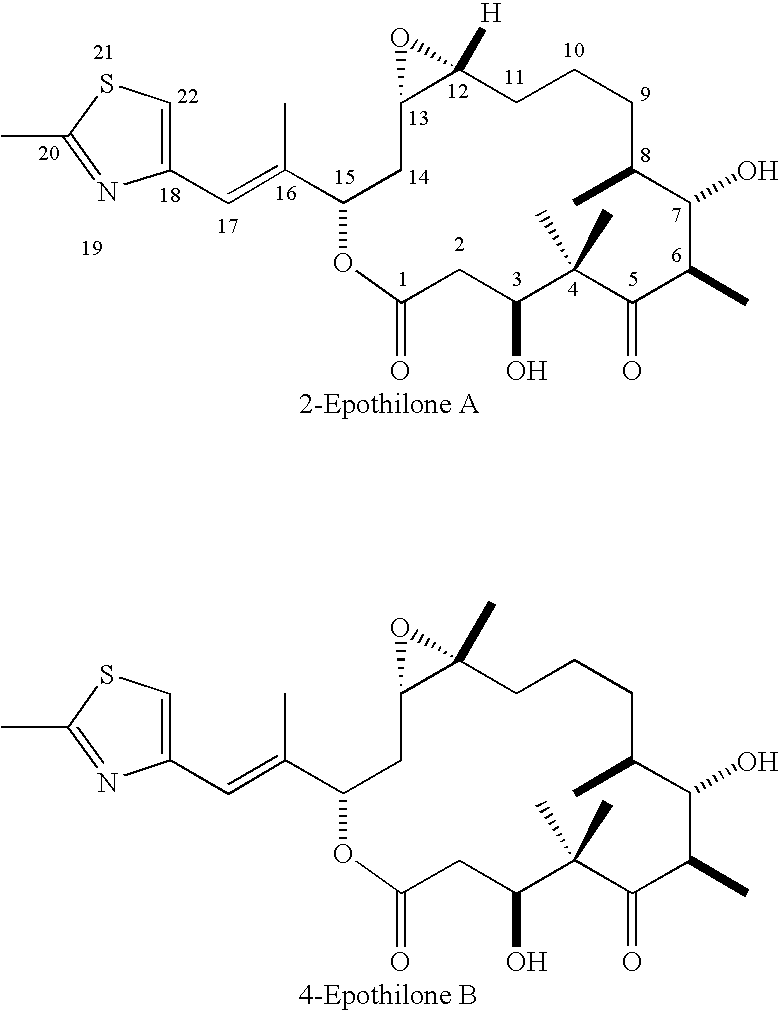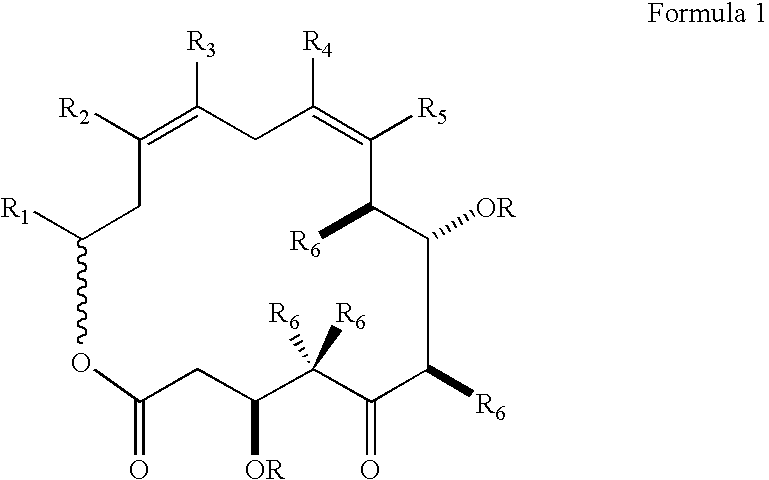Method for synthesizing epothilones and epothilone analogs
a technology of which is applied in the field of making epothilone and epothilone analog, and compounds, can solve the problems of inability to divide cells, interfere with the formation and growth of microtubules, and kill cells, and achieve the effect of inhibiting nitric oxide production
- Summary
- Abstract
- Description
- Claims
- Application Information
AI Technical Summary
Benefits of technology
Problems solved by technology
Method used
Image
Examples
example 1
[0065] This example describes the synthesis of compound 44 of Scheme 1. To a stirred solution of the alcohol precursor to 44 (1.03 g, 5.20 mmol) in CH2Cl2 (20 mL) was sequentially added DHP (580 mg, 630 μL, 6.91 mmol), followed by PPTS (110 mg, 0.438 mmol). After 1.5 hours, the reaction was quenched with solid NaHCO3 (5 g), filtered, concentrated in vacuo and purified by chromatography over silica gel, eluting with 30% Et20 / petroleum ether, to give 44 (1.42 g, 5.00 mmol, 96%) as a colorless oil: IR (neat) 2940, 1445 cm−1; 1H NMR (300 MHz, CDCl3) δ 6.04 (s, 1H), 4.62 (t, J=3.0 Hz, 1H), 4.26 (d, J=12.1 Hz, 1H), 4.16 (d, J=12.1 Hz, 1H), 3.85-3.95 (m, 1H), 3.5-3.6 (m, 1H), 1.95 (d, J=1.5 Hz, 3H), 1.5-1.9 (m, 6H); 13C NMR (75 MHz, CDCl3) δ 144.6, 98.4, 75.8, 72.1, 62.5, 30.7, 25.6, 22.2, 19.6; HRMS (CI) calculated for C9H16O2 (M+H+) 283.0195, found 283.0198.
example 2
[0066] This example describes the synthesis of compound 46. To a stirred solution of t-BuLi (48 mL, 62.4 mmol, 1.3 M in pentane) in Et20 (63 mL) at −78° C. was added a solution of 44 (10.27 g, 36.4 mmol) in Et20 (75 mL) via syringe pump over 20 minutes. After 20 minutes, the slurry was rapidly transferred to a precooled solution of CuCN (1.58 mg, 17.7 mmol) in THF (122 mL) at −78° C. After 1 hour at −78° C. and 5 minutes at −40° C., the solution was recooled to −78° C., and a precooled solution of 42 (3.40 g, 14.7 mmol) in THF (86 mL) was added via cannula. An additional amount of THF (25 mL) was added to rinse the flask. After 30 minutes, the solution was warmed to 0° C., and after a further 10 minutes the reaction was quenched with saturated aqueous NH4Cl (300 mL) and extracted with Et20 (3×150 mL). The dried (Mg2S04) extract was concentrated in vacuo and purified by chromatography over silica gel, eluting with 15-50% Et20 / petroleum ether, to give 46 (5.05 mg, 13.1 mmol, 89%) as a...
example 3
[0067] This example describes the synthesis of compound 48. To a stirred solution of NaHMDS (7.6 mL, 7.6 mmol, 1 M in THF) in THF (35 mL) at −78° C. was added a solution of the alcohol precursor to 46 (2.482 g, 6.41 mmol) in THF (50 mL) via syringe pump over 30 minutes. An additional amount of THF (5 mL) was added to rinse the syringe. After 20 minutes, a precooled solution of oxaziridine (2.55 g, 9.77 mmol) in THF (8 mL) was quickly added via cannula. After 6 minutes, the reaction was quenched with a solution of CSA (3.54 g, 15.2 mmol) in THF (10 mL). After 2 minutes, saturated aqueous NH4Cl (75 mL) was added. The mixture was allowed to warm to room temperature and was concentrated in vacuo to remove THF. The aqueous layer was extracted with Et20 (4×100 mL). The dried (Mg2S04) extract was concentrated in vacuo and purified by chromatography over silica gel, eluting with 50-70% Et20 / petroleum ether, followed by chromatography over silica gel, eluting with 2-4% acetone / CH2Cl2, follow...
PUM
 Login to View More
Login to View More Abstract
Description
Claims
Application Information
 Login to View More
Login to View More - R&D
- Intellectual Property
- Life Sciences
- Materials
- Tech Scout
- Unparalleled Data Quality
- Higher Quality Content
- 60% Fewer Hallucinations
Browse by: Latest US Patents, China's latest patents, Technical Efficacy Thesaurus, Application Domain, Technology Topic, Popular Technical Reports.
© 2025 PatSnap. All rights reserved.Legal|Privacy policy|Modern Slavery Act Transparency Statement|Sitemap|About US| Contact US: help@patsnap.com



